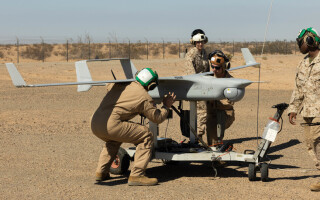Curtiss-Wright
Suite 200
Ashburn, Virginia 20147 [email protected]
https://www.curtisswrightds.com/

Avionics upgrades to be provided to UH-60L foreign military fleets - News
May 15, 2025NASHVILLE, Tennessee. ACE Aeronautics chose Ultra PCS and Curtiss-Wright Defense Solutions to supply an integrated cockpit voice recorder (CVR), flight data recorder (FDR), and health and usage monitoring system (HUMS) for UH-60L Black Hawk helicopters operated by foreign militaries, the companies announced in a statement.
Airborne attritable systems and open systems - Story
March 18, 2025The U.S. Department of Defense (DoD) is investing heavily in airborne attritable systems as a cost-effective approach to project force and influence. The DoD’s directive to use modular open systems approach (MOSA)-based solutions positions commercial off-the-shelf (COTS) component vendors to meet the form factor, weight, and cost limit requirements of airborne drones uncrewed aerial systems (UASs). This move toward lower-cost and more easily replaced uncrewed systems opens up new opportunities for suppliers of COTS components.
Implementing RAID configurations for deployed NAS systems - Story
March 17, 2025Network-attached storage (NAS) systems for mission-critical applications often rely on a redundant array of independent disk (RAID) configurations to mitigate data loss from disk failures, improve data throughput speed, and maximize storage efficiency. Users can effectively implement RAID to optimize their NAS systems and ensure critical data protection in deployed environments by carefully considering storage capacity, performance, and platform requirements.
High-speed data acquisition systems to be provided to U.S. Navy by Curtiss-Wright - News
March 12, 2025ASHBURN, Virginia. Curtiss-Wright won a $50 million firm-fixed-price Indefinite Delivery, Indefinite Quantity (IDIQ) contract from Naval Air Systems Command (NAVAIR) to supply high-speed data acquisition systems and repair services for the Special Flight Test Instrumentation Pool, the company announced in a statement.
Tactical comms tech to be supplied to U.S. Marines by Curtiss-Wright - News
March 07, 2025ASHBURN, Virginia. Curtiss-Wright’s Defense Solutions Division won an $18 million contract from the U.S. Marine Corps to provide Modular Open Systems Approach (MOSA)-based tactical communications technology for the Combat Data Network (CDN) program, the company announced in a statement.
CJADC2 interoperability: AI-/ML-based sensor fusion at the edge - Story
November 25, 2024The U.S. Department of Defense (DoD) Coalition Joint All-Domain Command and Control (CJADC2) system is revolutionizing modern military operations by integrating data across all military domains: land, air, sea, space, and cyberspace. For effective multidomain operations, sensor data needs to be processed rapidly and shared across different military branches. Achieving this level of interoperability requires sophisticated technologies to handle vast and complex data streams in real time, particularly artificial intelligence (AI) and parallel sensor fusion processing at the edge.
SOSA aligned avionics systems for UAVs to be developed by KAL, Curtiss-Wright - News
November 15, 2024ASHBURN, Virginia. Curtiss-Wright’s Defense Solutions Division and Korean Air’s Research & Development Group signed a Memorandum of Understanding (MOU) to collaborate on avionics systems for medium and large uncrewed aircraft that is aligned with the Sensor Open Systems Architecture, or SOSA, Technical Standard, the companies announced in a statement.











